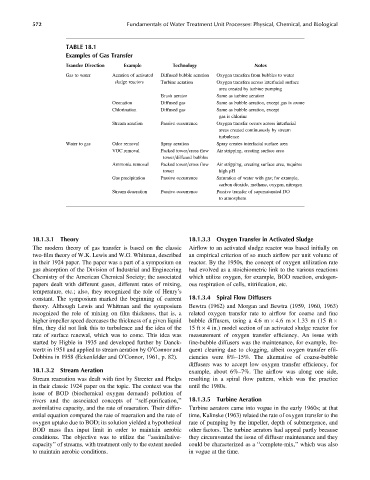Page 617 - Fundamentals of Water Treatment Unit Processes : Physical, Chemical, and Biological
P. 617
572 Fundamentals of Water Treatment Unit Processes: Physical, Chemical, and Biological
TABLE 18.1
Examples of Gas Transfer
Transfer Direction Example Technology Notes
Gas to water Aeration of activated Diffused bubble aeration Oxygen transfers from bubbles to water
sludge reactors Turbine aeration Oxygen transfers across interfacial surface
area created by turbine pumping
Brush aerator Same as turbine aeration
Ozonation Diffused gas Same as bubble aeration, except gas is ozone
Chlorination Diffused gas Same as bubble aeration, except
gas is chlorine
Stream aeration Passive occurrence Oxygen transfer occurs across interfacial
areas created continuously by stream
turbulence
Water to gas Odor removal Spray aeration Spray creates interfacial surface area
VOC removal Packed tower=cross flow Air stripping, creating surface area
tower=diffused bubbles
Ammonia removal Packed tower=cross flow Air stripping, creating surface area, requires
tower high pH
Gas precipitation Passive occurrence Saturation of water with gas; for example,
carbon dioxide, methane, oxygen, nitrogen
Stream deaeration Passive occurrence Passive transfer of supersaturated DO
to atmosphere
18.1.3.1 Theory 18.1.3.3 Oxygen Transfer in Activated Sludge
The modern theory of gas transfer is based on the classic Airflow to an activated sludge reactor was based initially on
two-film theory of W.K. Lewis and W.G. Whitman, described an empirical criterion of so much airflow per unit volume of
in their 1924 paper. The paper was a part of a symposium on reactor. By the 1950s, the concept of oxygen utilization rate
gas absorption of the Division of Industrial and Engineering had evolved as a stoichiometric link to the various reactions
Chemistry of the American Chemical Society; the associated which utilize oxygen, for example, BOD reaction, endogen-
papers dealt with different gases, different rates of mixing, ous respiration of cells, nitrification, etc.
temperature, etc.; also, they recognized the role of Henry’s
constant. The symposium marked the beginning of current 18.1.3.4 Spiral Flow Diffusers
theory. Although Lewis and Whitman and the symposium Bewtra (1962) and Morgan and Bewtra (1959, 1960, 1963)
recognized the role of mixing on film thickness, that is, a related oxygen transfer rate to airflow for coarse and fine
higher impeller speed decreases the thickness of a given liquid bubble diffusers, using a 4.6 m 4.6 m 1.33 m (15 ft
film, they did not link this to turbulence and the idea of the 15 ft 4 in.) model section of an activated sludge reactor for
rate of surface renewal, which was to come. This idea was measurement of oxygen transfer efficiency. An issue with
started by Higbie in 1935 and developed further by Danck- fine-bubble diffusers was the maintenance, for example, fre-
wertz in 1951 and applied to stream aeration by O’Connor and quent cleaning due to clogging, albeit oxygen transfer effi-
Dobbins in 1958 (Eckenfelder and O’Connor, 1961, p. 82). ciencies were 8%–15%. The alternative of coarse-bubble
diffusers was to accept low oxygen transfer efficiency, for
18.1.3.2 Stream Aeration example, about 6%–7%. The airflow was along one side,
Stream reaeration was dealt with first by Streeter and Phelps resulting in a spiral flow pattern, which was the practice
in their classic 1924 paper on the topic. The context was the until the 1980s.
issue of BOD (biochemical oxygen demand) pollution of
rivers and the associated concepts of ‘‘self-purification,’’ 18.1.3.5 Turbine Aeration
assimilative capacity, and the rate of reaeration. Their differ- Turbine aerators came into vogue in the early 1960s; at that
ential equation compared the rate of reaeration and the rate of time, Kalinske (1963) related the rate of oxygen transfer to the
oxygen uptake due to BOD; its solution yielded a hypothetical rate of pumping by the impeller, depth of submergence, and
BOD mass flux input limit in order to maintain aerobic other factors. The turbine aerators had appeal partly because
conditions. The objective was to utilize the ‘‘assimilative- they circumvented the issue of diffuser maintenance and they
capacity’’ of streams, with treatment only to the extent needed could be characterized as a ‘‘complete-mix,’’ which was also
to maintain aerobic conditions. in vogue at the time.

